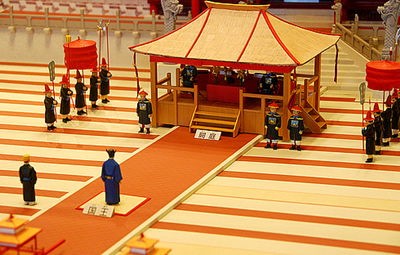 |
| Qing Tributary System |
The Chinese tributary system dated to the Han dynasty (202 b.c.e.–220 c.e.). It reflected the Chinese worldview that China was the center of the civilized world, and that all lands desiring relations with China must be tributary states. The Qing (Ch’ing) tributary system was inherited from its predecessor Ming dynasty (1368–1644) with additions and modifications.
The basis of the tributary system was acceptance of Chinese cultural superiority. Non-Chinese or barbarians, if willing to travel to court and perform the prescribed rituals, could be accepted into the Confucian sphere of states. Rulers or envoys of vassal states offered tribute or gifts and received in return the Chinese emperor’s seal of recognition and return gifts, generally much in excess of the tribute.
There were four main functions of the tribute system. First, it maintained the preeminence of China among the peripheral peoples. Second, it was a political means of self-defense. Third, it was a means of trade. Fourth, it was a way of conducting diplomacy.
  |
Through early Ming China’s strength on land and sea it became the suzerain of many tributary or vassal states. They included Korea, the Ryukyu Islands, Annam (Vietnam), Burma, Siam, and a host of other states in Southeast and Central Asia from Bengal to the Philippines to Samarkand.
The Reception Department, a bureau of the Chinese government, regulated the size, frequency, and reception of the tribute missions that depended on each’s importance to and distance from China.
For example Korea paid tribute four times a year; Annam once every two years; Siam every three years; and Laos and Burma every 10 years. While in China, all expenses of the tribute missions were paid by the Chinese government. Regulations also governed the number of merchants and amount of trade allowed to accompany each tribute mission.
As the Ming dynasty declined, the newly established, and as yet regional Qing or Manchu dynasty set up an office called Lifanyuan (Li-fan Yuan) or Court of Colonial Affairs in 1638.
Its mission was to manage affairs relating to Mongolia, Tibet (including dealing with the Dalai Lama), the Western Regions (present-day Xinjiang [Sinkiang]), and Korea. It kept track of titles and defined the domains of Mongol chiefs to prevent tribal wars and regulated the Mongols’ relations with their spiritual leaders in Tibet.
After 1644, its functions were enlarged to supervising the semiabsorbed tribal peoples of southwestern China in Yunnan, Guizhou (Kweichow), and Sichuan (Szechuan) provinces. In short the Lifanyuan dealt with frontier peoples and ethnic minorities in the Qing empire outside the Chinese style of civil administration.
Europeans who traveled to China via sea during the Ming dynasty encountered this system of international relations. Although Western nations were not formally enrolled among the tributary states because of their great distance from China, envoys from Portugal, the Netherlands, and Russia were received at the Qing court as tribute ambassadors.
Between 1655 and 1795, 17 missions from Western nations were received by the Qing monarchs, and all except the last, the British ambassador Lord Macartney, performed the kowtow before the emperor. This style of international relations between China and Western nations ended in 1842 after Great Britain defeated China in the First Anglo-Chinese War, although it persisted between China and its traditional vassal states until the late 19th century.
EmoticonEmoticon